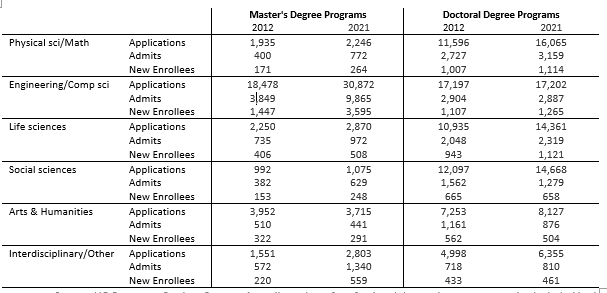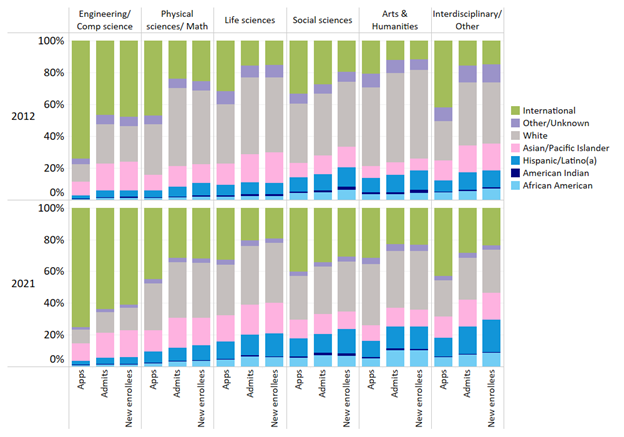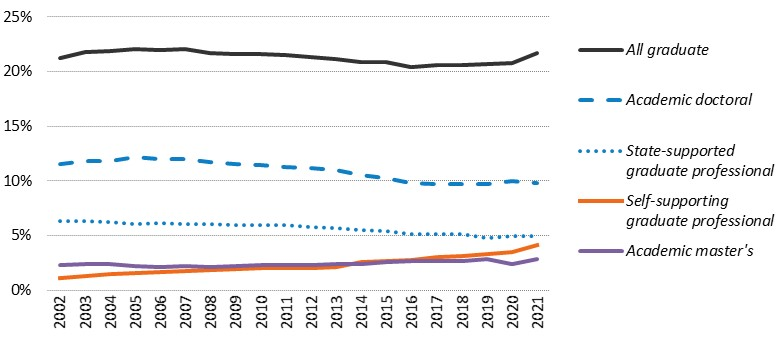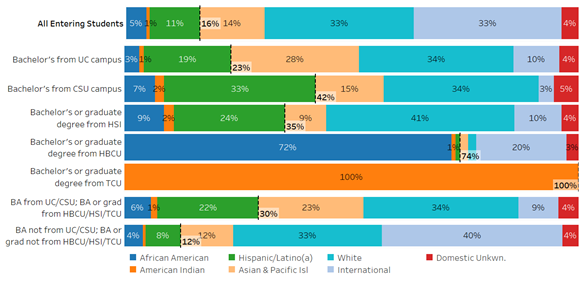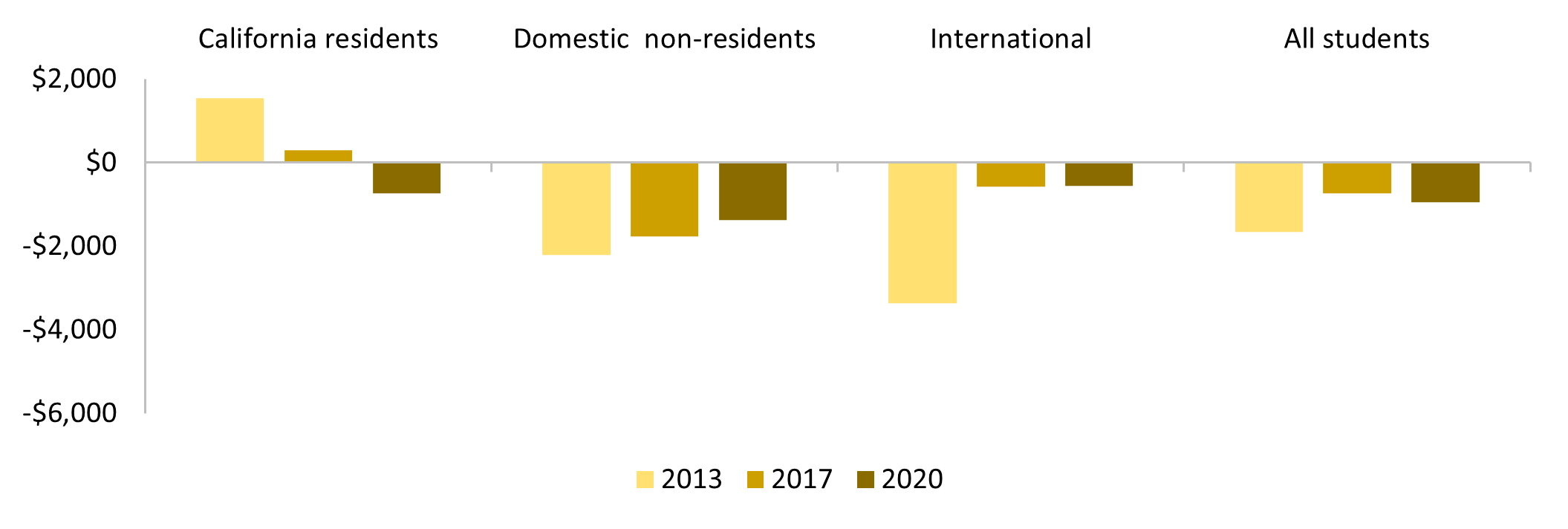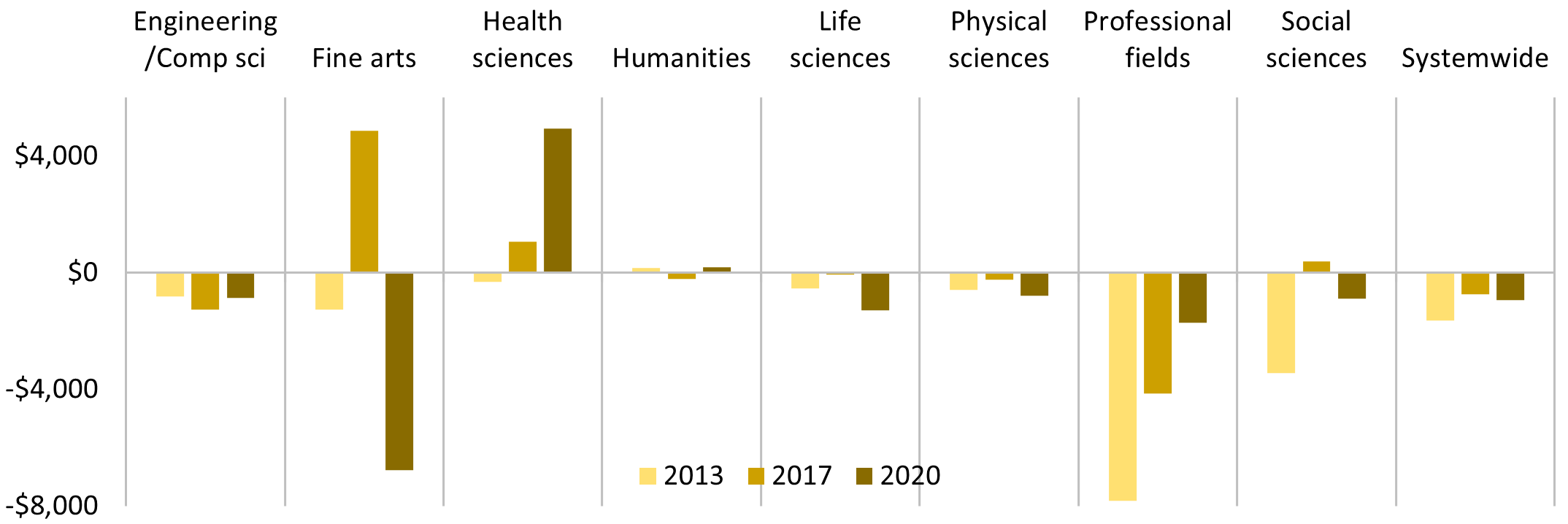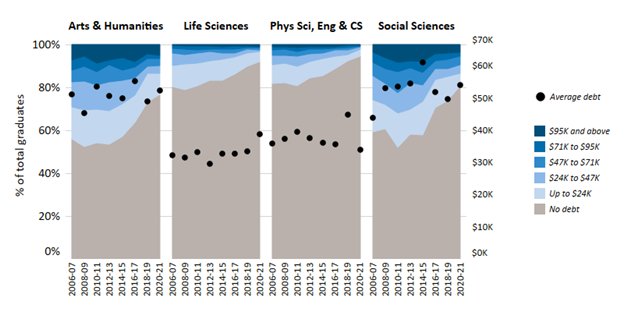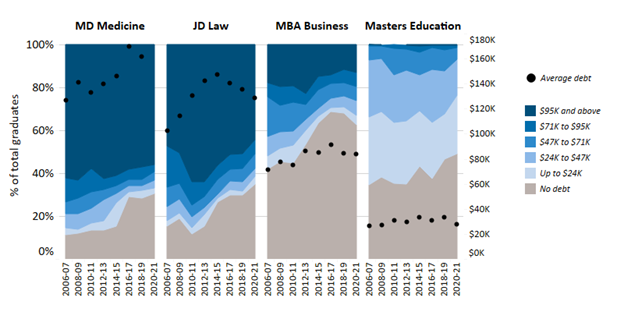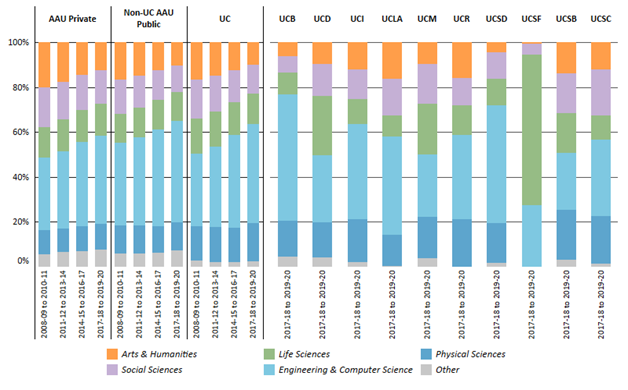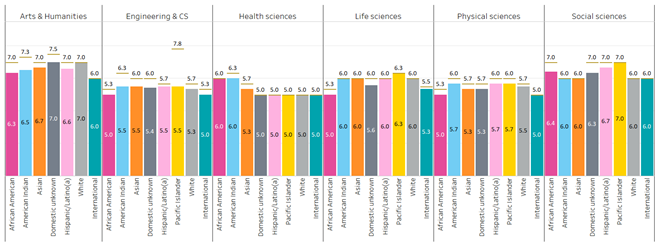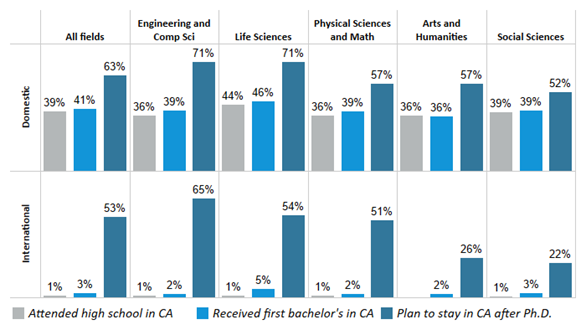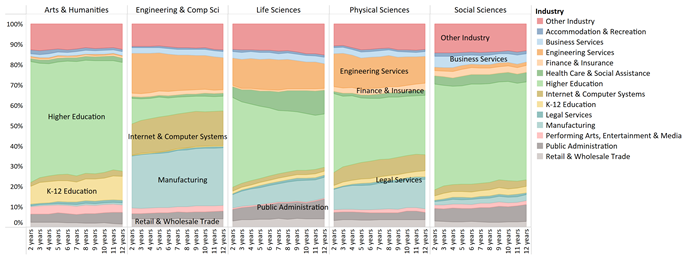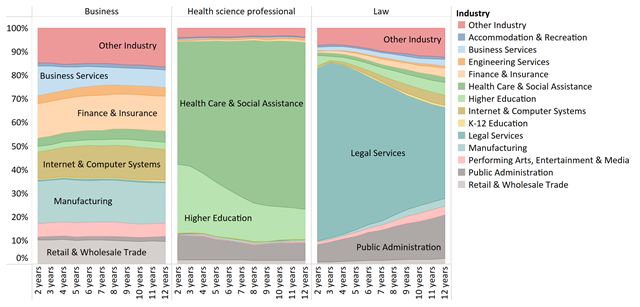UC Merced Applied Mathematics Ph.D. student Cory Mccullough is teaching statistics to incarcerated students at two local prisons through the Merced College Rising Scholars Program.
In his early 20s, Cory Mccullough battled addiction and stole to support his habits. The Dos Palos native spent several stints in prison as early as 2011 for commercial burglary. Education was the last thing on his mind. Motivated by the desire to make a life for his kids, he enrolled at Merced College. Like many adult community college students, it took more than one attempt for the passion to learn to stick. But it did and he was a member of two honor societies: Phi Theta Kappa and Alpha Gamma Sigma.
Now, the former inmate finds himself in the joint again, this time not behind bars but helping incarcerated people forge their paths to higher education. The third-year UC Merced Ph.D. candidate is using his experiences and education to teach incarcerated students through the Merced College Rising Scholars Program. The program partners with the California Department of Corrections and Rehabilitation and serves 600 students at two state prisons in Chowchilla: Valley State Prison and Central California Women's Facility.
“They are exceedingly driven (as students) because they don't want to go back to where they've been. No other students I know have that kind of dedication.” Like Mccullough recognized, education can be the key to changing circumstances. “It means a lot for me to go in there and show them that they can do something different with their lives,” Mccullough said.
Goals
California’s Master Plan for Higher Education gives the University of California the responsibility of enrolling and preparing graduate academic and professional students to help meet the needs of California and the nation and to further the UC mission of teaching, research, and public service. Thus, reviving adequate support for the University of California is important, as its graduate education enterprise fuels California’s role as a national and international leader.
UC’s goals for graduate education are to offer outstanding degree programs, advance research, support undergraduate instruction, and prepare students to join a professional workforce or innovate on behalf of it. UC produces the leaders of the future — the teachers, artists, thinkers, innovators, scientists, inventors, doctors, lawyers, and nurses; and it creates an environment of exploration and discovery that stimulates innovation and invention. UC’s internationally renowned graduate education enterprise serves to drive California’s economy and its role as a global leader. UC graduate education allows California to grow, create jobs, drive industry, tackle unique challenges facing the state, and help improve the everyday lives of its inhabitants.
Types of graduate degrees
UC awards both graduate academic degrees and graduate professional degrees.
Graduate academic degrees — These include academic doctoral and academic master’s degrees in education, life sciences, physical sciences, social sciences, arts, humanities, and engineering/computer science. The largest proportion of graduate academic degrees awarded at UC is in the STEM fields — science, technology, engineering, and mathematics. From the 2016–17 to 2020–21 academic years, more than 70 percent of UC graduate academic degrees were awarded in STEM fields.
Graduate professional degrees — UC’s professional degrees include professional master’s and professional practice degrees in fields such as law, medicine, nursing, business, education, architecture, public policy, and the arts. The graduate professional category includes professional master’s degrees (e.g., M.B.A., M.Ed.) and professional practice degrees (e.g., J.D., M.D.). In the field of medicine, UC offers the nation’s largest instructional program in health care and health sciences.
The University maintains multiple funding models for its graduate professional programs. Many partially State-supported programs (e.g., M.B.A., law, medicine) assess professional degree supplemental tuition (PDST), which allows the professional schools to ensure their excellence, accessibility, and inclusiveness, and assists with affordability (by requiring return-to-aid for tuition revenue). Programs assessing PDST commit substantial resources to student financial support, including grants and scholarships. Since PDST began in 1994, both the number of professional degree programs that charge PDST and the amount charged have increased. Currently over 60 graduate professional programs charge PDST, ranging from $8,000 to $51,000 per year in addition to systemwide tuition and campus-based fees.
Other UC graduate professional programs, primarily master’s programs, follow a self-supporting funding model. The largest are business and management programs. These programs receive no State support and are funded entirely by revenues generated by the program and other non-State revenues. Self-supporting programs allow the University to serve additional students beyond those supported through State resources. They also fulfill higher education and workforce needs. Some self-supporting programs serve nontraditional populations such as full-time employees, mid-career professionals, and international students with specialized goals. Many programs are offered through an alternative mode of delivery, such as online or hybrid instruction, alternative scheduling, or at off-campus locations.
Graduate enrollment share
UC’s graduate education enterprise enrolls over 64,000 students, with doctoral students representing the largest number (29,200), and professional (26,500) and master’s (8,200) comprising the remainder. Despite its size, UC’s graduate education enterprise represents a smaller share of its total enrollment than that of its peers. Graduate students comprise 21 percent of total student enrollment at UC, which is lower than the proportion of graduate enrollment among other Association of American Universities (AAU) public (28 percent) and private (56 percent) peer institutions. In addition, while the graduate share of UC’s total enrollment has remained relatively constant over the last decade at 21 percent, the doctoral enrollment percentage has declined. The graduate professional percentage has risen steadily (4.2.1). Despite these enrollment trends, UC research degree production is comparable to other public university competitors. For example, in number of research degrees produced and percentage of research degrees produced in comparison to other types of degrees, UC compares favorably to its competitors. While enrollment needs will vary by program, it is important that academic doctoral student enrollment be supported at sufficient levels to drive UC’s research enterprise and support faculty innovation and retention.
UC is pursuing a multi-year framework with the goal of increasing degree attainment and producing 200,000 more degrees through 2030, About 40,000 of these additional degrees would be at the graduate level.
Supporting diverse career paths and making research accessible
To promote and highlight the work of master’s and doctoral students across UC campuses, UC holds an annual research communication competition called UC Grad Slam (gradslam.universityofcalifornia.edu). The event challenges its ten participants — the winners of each campus’s Grad Slam — to distill years of academic research into a three-minute presentation free of technical lingo. Grad Slam encourages students to communicate their research in a clear and compelling way to non-specialists — a skill that employers need and value. Campuses provide workshops and resources for students to develop this skill set. The contest also demonstrates to the public that UC research benefits their lives in both ordinary and quite extraordinary ways. While UC was unable to hold the 2020 installment of systemwide Grad Slam due to the coronavirus pandemic, Grad Slam returned in a virtual format in 2021. In 2022, the systemwide Grad Slam returned to an in-person competition but without a public audience due to continued pandemic-related limitations. The event was livestreamed, and the winner was Justin Lee from UC Berkeley for his talk on how genetic engineering could be used to stop COVID from replicating inside the body. Also taking home prizes for their outstanding talks were Amanda Quirk of UC Santa Cruz, who won second place for explaining her research into how galaxies collide; Rachel Sousa of UC Irvine, who snagged third place for her talk on how math can help us find a cure for cancer; and Wei Gordon of UCSF, who won the People’s Choice award for a talk on mutations that help fruit-eating mammals metabolize sugar.
UC Graduate Student Experience Survey (UCGSES)
In 2021, UC launched the UC Graduate Student Experience Survey (UCGSES). This systemwide survey was developed based on the UC Graduate Well Being Survey, Ph.D. Career Pathways Survey, and UC campus graduate and professional student surveys. This survey will be administered every two years to solicit graduate and professional students’ opinions on a broad range of academic and co-curricular experiences, including instruction and training, advising, basic needs, student services, and campus climate.
Results showed that about 65 percent of academic doctoral respondents reported they were confident in their financial situation and could get by financially without having to cut back on what was important to them. At the same time, about one-third reported that financial hardship had impeded their success in their program. Findings also revealed differences in financial confidence and hardship exists among students across disciplines. For example, students in Arts, Humanities, and Social Sciences were less likely to report that they were confident in their financial situation compared to other disciplines, and more than half of respondents in Arts and Humanities reported financial hardship had impeded their success. In addition, students from underrepresented racial/ethnic groups (Black/African American, American Indian, and Hispanic/Latino(a)), first-generation students, women, and LGBTQ students reported being less confident in their financial situation than other students. One way UC campuses plan to help increase academic doctoral student financial confidence is by providing multi-year funding/support offers at the time of admission to provide greater assurance regarding the amount and consistency of financial support students can expect throughout their program. Presently, the minimum duration of support offered to students upon admissions varies. However, it is a UC goal for campuses to ensure that all academic doctoral students will receive a minimum of a five-year funding package upon admission. This is the current practice at UC Irvine, UC San Diego, and UC Santa Cruz.
Additionally, African American and American Indian graduate and professional students are less likely than other students to feel that their culture is respected on campus. These data are presented in Chapter 7: Diversity, indicators 7.2.3 and 7.2.4, and the whole UCGSES survey can be explored at this dashboard: universityofcalifornia.edu/about-us/information-center/UCGSES-data-tables
Equity and inclusion: Expanding academic pathways
A more diverse and inclusive community of scholars at all levels has been a longstanding goal for UC, but progress at the doctoral, postdoctoral, and faculty levels has lagged compared to the undergraduate level. UC’s difficulties reflect challenges in both enrolling individuals from underrepresented groups in doctoral programs and in attracting and hiring them as postdoctoral scholars and faculty. Improving retention of faculty from underrepresented groups is also important. Improving climate and inclusion at UC continues to be critical to its excellence and future. There is a new systemwide initiative aimed at improving inclusion within UC’s academic community. It is:
Growing Our Own: Graduate Enrollment and Diversifying Ph.D. Pathways Initiative — To support and enhance the career path to the professoriate, the UC Council of Vice Chancellors (COVC) developed this important new systemwide effort. The initiative aims to increase the number and proportion of UC undergraduate degree recipients who earn an academic doctoral degree, and to increase the number and proportion of UC academic doctoral graduates from UC, California State University (CSU), other Hispanic-Serving Institutions (HSIs), Historically Black Colleges and Universities (HBCUs), and Tribal Colleges and Universities (TCUs). With this initiative, UC aims to build sustainable pathways for students from first-generation, low-income, and underrepresented racial/ethnic groups to the professoriate, in California and beyond. The initiative recognizes the importance of multiple interventions and partners — scaled up and sustained over time — to identify and cultivate talent for California’s future professoriate. The initiative seeks to expand existing programs at UC, create stronger connections among institutions of higher education for identifying and cultivating talent, and prioritize academic doctoral training for California undergraduates who collectively come from backgrounds as diverse as California itself. Using relevant data, each UC campus established growth targets achievable by 2030 for Ph.D. enrollments from UC undergraduates and students from CSU, HBCU, HSI, and TCU institutions, ranging from 27 to 40 percent. To achieve the growth targets, each campus has developed a plan aligned with the systemwide Growing Our Own strategic framework. In order for UC to maximize progress and appropriately widen the pathways to California’s professoriate, particularly for first-generation students and scholars from underrepresented communities of color, additional investment from the state is needed.
Growing Our Own is providing an infrastructure to better elevate, connect, and advance a range of pathways and inclusion efforts. Below are a few examples of such programs:
UC LEADS — The University of California Leadership Excellence through Advanced DegreeS (UC LEADS) program prepares promising UC undergraduate students for advanced education in science, technology, engineering, and mathematics (STEM) fields. The program prepares underrepresented UC undergraduate students for doctoral education opportunities at a UC campus.
From its inception in 2000, 1,153 scholars participated in UC LEADS, celebrating 20 years of programmatic effort and yielding significant outcomes. Ninety-nine percent of UC LEADS scholars graduate with their undergraduate degree, 76 percent pursue graduate school or have already earned degrees in a master’s or doctoral program, and 48 percent of UC LEADS scholars attended UC for graduate school. Given the importance of gender and ethnic equity within STEM-based doctoral programs, it is notable that 50 percent are women, 53 percent are first-generation college students, and 52 percent are from underrepresented minority groups. Thirty-seven UC LEADS alumni are now working as tenure track faculty, including seven within the UC system, while another 12 are employed in non-tenure track faculty positions, and 11 hold other academic career positions. Others work around the world as industry and government scientists, teachers, medical doctors, and entrepreneurs. It is also worth noting that 28 percent of scholars who enroll in a UC graduate program do so at the campus where they spent their second UC LEADS summer experience — further illustrating the impact and significance of the relationships that students build through this program.
UC-Hispanic Serving Institutions Doctoral Diversity Initiative (UC-HSI DDI) — Launched in fall 2019, the UC-HSI DDI aims to improve faculty diversity by enhancing pathways to the professoriate for underrepresented students from California Hispanic Serving Institutions (HSIs). The UC-HSI DDI includes two components: 1) competitive grant awards to UC faculty/faculty administrators to support short-term and long-term programs/projects to enhance and expand pathways to the professoriate for underrepresented students; and 2) funding to directly support graduate student preparation for the professoriate. Funding includes resources to support a limited number of Ph.D. students (two per campus), named UC President’s Pre-Professoriate Fellows (UC PPPF), who are California HSI alumni and have advanced to candidacy at UC. The UC President’s Pre-Professoriate Fellowship fosters their interest in and preparation for the professoriate. Additional professional development support for underrepresented Ph.D. students is provided to campus graduate divisions to encourage and help more scholars explore opportunities to help them consider, and pursue, careers in the professoriate. Another goal of the UC-HSI DDI is to enhance the climate of academic programs through interventions, incentives, and efforts that foster an academic culture of inclusion and equity — especially for faculty and students from underrepresented communities.
In two cycles, the UC-HSI DDI grants program has supported ten projects: five small grants (up to $50K) and five large grants (up to $350K). The lead investigators represent projects from seven different UC campuses: Davis, Riverside, and Santa Cruz each with two grants; and Irvine, Los Angeles, Merced, and San Diego each with one grant. The ten funded grants cover a broad range of disciplines/areas, including five in STEM, three in social sciences, and two interdisciplinary; together, these projects partner with more than 40 institutions and support nearly 450 students. The program has received significant interest, generating 59 grant applications and more than $13M in funding requests in only two cycles. The initiative has also supported 35 UC President’s Pre-Professoriate Fellows since the program’s inception, three of whom have been awarded the prestigious UC President’s Postdoctoral Fellowship.
UC-HBCU Initiative — The University of California-Historically Black Colleges and Universities (UC-HBCU) Initiative was established to increase the number of African Americans completing Ph.D.’s at UC by investing in relationships between UC faculty and HBCUs. The program has raised UC’s profile within the HBCU community and facilitated faculty research collaborations in addition to enrolling, retaining and graduating students. UC has hosted 700 UC-HBCU summer interns across nine campuses since it first hosted students in summer 2012. UC currently has 78 Ph.D. fellows enrolled across all ten UC campuses as a direct result of the Initiative: 68 percent in STEM fields, and 32 percent in Social Sciences/Humanities. Thirteen Ph.D. and 16 master’s students have graduated. Of the 13 Ph.D. graduates, five (38 percent) have secured tenure track positions in the professoriate, two in California, at UC Irvine and William Jessup University. One graduate is teaching at Penn State, Brandywine, and two have been hired as faculty at HBCUs (Fisk University and Howard University). Two Ph.D. graduates were awarded the President’s Postdoctoral Fellowship (PPFP), which helped them to secure faculty appointments, and others have also obtained prestigious postdoctoral appointments and employment positions. These alumni are making important contributions to California, the nation, and the world.
University of California President’s Postdoctoral Fellowship Program (PPFP) — The PPFP was established to encourage outstanding women and minority Ph.D. recipients to pursue academic careers at UC. The program offers postdoctoral research fellowships, professional development, and faculty mentoring to outstanding scholars in all fields whose research, teaching, and service will contribute to diversity and equal opportunity at UC. More information about the PPFP is presented in Chapter 5.
Looking ahead
UC is committed to expanding pathways to research and advanced degrees so that innovation can be driven at the highest levels and to propel California to lead the way with a diverse professoriate. Inclusion and equity are critical to the continued success and prominence of UC’s research enterprise. In addition to the programs noted above that help advance the Growing Our Own: Graduate Enrollment and Diversifying Ph.D. Pathways initiative, UC is launching two related pilot programs:
UC-California Community College Faculty Internship Program (UC-CCCFIP) 3-year Pilot. This pilot builds on UC Irvine’s current faculty internship program with California Community Colleges (the California Community College Internship Program-CCCIP), to support an expansion of the program to include additional UC and CCC campuses, and provide more competitive student stipends to attract Ph.D. students from underserved and diverse communities. This effort will promote pathways into faculty positions at California Community Colleges (CCC). The program will help expose UC students and encourage them to train for the professoriate, engage with undergraduate students from the California Community College system, and model advanced degree aspirations for CCC students. The systemwide pilot will be inclusive of all disciplines, but priority areas/fields will be identified by CCC. The UCI program has served nearly 100 students since it began, many of whom have gone on to careers as professors in CCCs, CSUs, and UCs.
Development of online Introduction to Research/Research Exposure course(s). California has an outstanding public higher education system, with UC, CSU, and CCC. UC’s role within the state is unique in that it is a research university system, yet it has no strategic mechanism to ensure that each and every UC student has research exposure/experience. Beyond a UC course, there is great value in developing research exposure courses, in collaboration with UC’s intersegmental partners, that will target California undergraduates at CCC and CSU. This will serve to expose and potentially better position students, from all backgrounds, to consider career opportunities fueled by research, careers that are critical to supporting the state’s advanced workforce needs. This project is a long-term pilot effort.
Looking ahead requires prioritizing investing in pathways to success for California undergraduates and focusing on expanding and diversifying California’s much-needed pool of workers and innovators to meet the state’s advanced workforce needs. This requires ensuring that those pursuing advanced degrees and professoriate opportunities are reflective of the state of California. UC is looking forward to working in collaboration with state leaders to support that vision for California’s future. Investing in Growing Our Own is key to sowing success.
For more information)
UCOP Graduate Studies (website)
UC Grad Slam (website)
UC-Hispanic Serving Institutions Doctoral Diversity Initiative (UC-HSI DDI) (website)
UC LEADS (website)
UC-HBCU Initiative (website)
President’s Postdoctoral Fellowship Program (website)
Time to doctorate at UC (dashboard)
Doctoral completion rates (dashboard)
Graduate student financial support and net cost of attendance (dashboard)
Employment and doctoral experience of Ph.D. recipients (dashboard)
Doctoral program data (dashboard)
UC Academic Planning Council, Graduate Education Workgroup’s Report “Recommendations for Greater Support of Doctoral Education,” (June 2019) (pdf)
Growing Our Own: Graduate Enrollment and Diversifying Ph.D. Pathways initiative (pdf)


